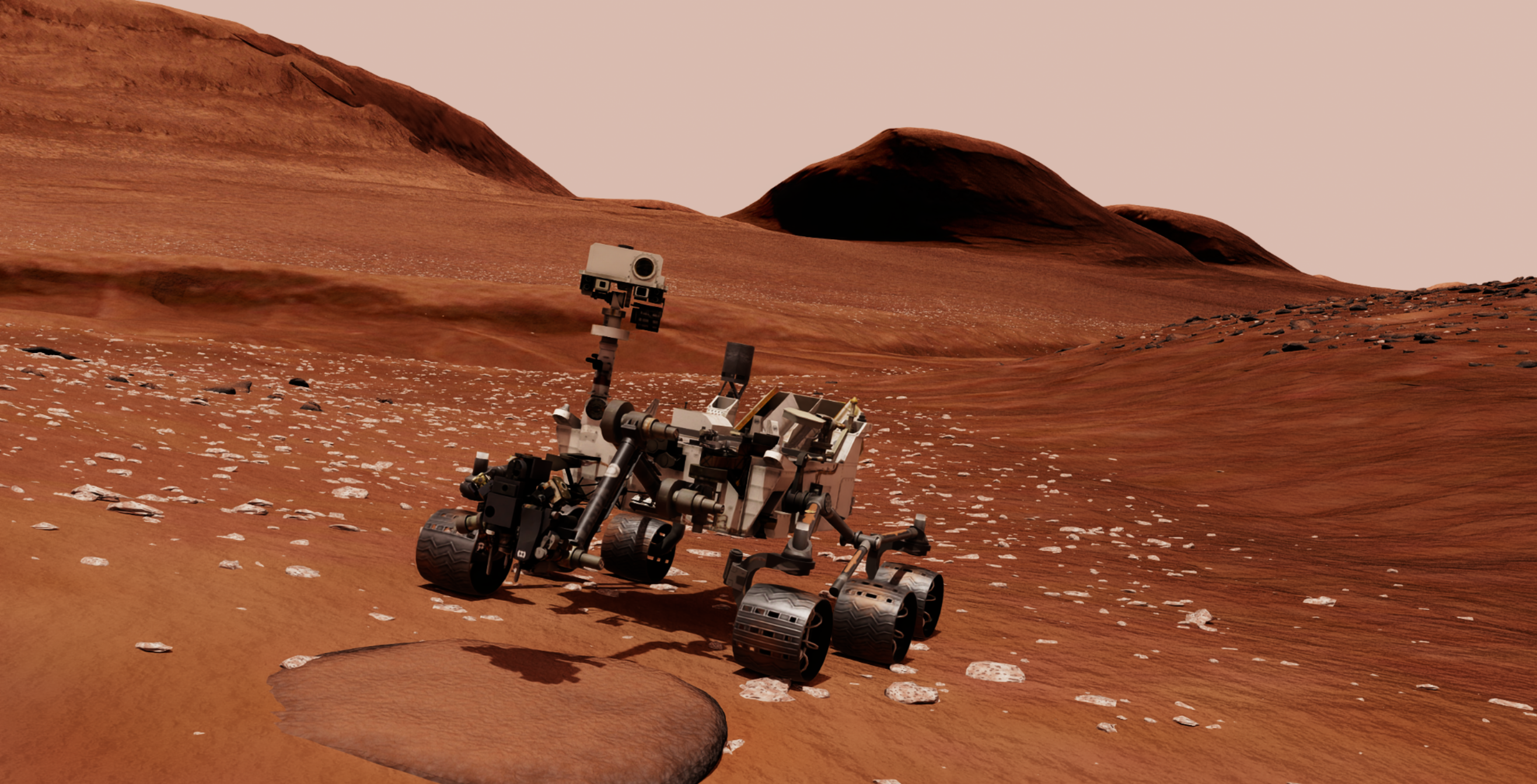This repository provides a Docker image for our NASA's Curiosity rover demo based on NVidia Isaac Sim that interfaces with Space ROS. We also built a digital twin of the Gediz Vallis Channel Environment, focusing on the area surrounding the recent event of sulfur stone discovery. The map was developed using the HIRISE Mars DTM (real Mars terrain data) and with custom-made rock assets that seamlessly blend into the environment. It provides a highly detailed replication of the environment for both current and future missions. As of September 2024, Curiosity is still exploring within this region.
- Docker image of NVIDIA Isaac Sim with Space ROS interface
- Digital twin environment of the Gediz Vallis channel sulfur stone discovery site with enhenced terrain features
- Curiosity rover asset integration into the simulation
- ROS2 interfaces for controlling the rover and sensor feedback
- Realistic graphic with Ray-Tracing technology
- PhysX engine for advanced physics simulation
- Built-in DLSS Frame Generation for improved performence
- Direct VR/AR support (with extension), useful in planetory exploration simulations
To run the Curiosity rover simulation in Isaac Sim, ensure your system meets the following requirements:
| Requirement | Description |
|---|---|
| OS | Ubuntu 22.04 |
| GPU | Nvidia RTX 30XX series or higher |
| RAM | 16 GB or higher |
| CPU | Intel i7 or higher |
| NVIDIA Driver | ver. 560.35.03 (exact ver. recommended) |
For more detailed hardware requirements, refer to the Isaac Sim Hardware Documentation.
The following software dependencies must be installed on your system:
| Dependency | Description |
|---|---|
| Docker Engine | Docker Installation Guide |
| NVIDIA Toolkit | NVIDIA Container Toolkit Installation |
Ensure the following Docker images are built and available on your system before running the simulation:
| Image | Description |
|---|---|
| space-robots | The base Docker image for space robotics research. |
| moveit2 | Provides MoveIt2 for motion planning. |
| space ros | Core ROS2 components for space robotics. |
Start the Docker with
sudo systemctl start docker
To build and launch the container you should cd to docker folder:
To build image use this script:
./build.shTo run docker container use this script:
./run.shThat's all you need to start the simulation environment.
The following repositories are cloned into the Docker container during the build process:
For an optimized development workflow, it is recommended to use Visual Studio Code (VSCode) along with its Docker-related extensions. These tools greatly simplify the process of interacting with Docker containers, especially when debugging and managing development environments.
- Dev Containers: Enables you to develop inside a Docker container.
- Docker Extension for VSCode: Simplifies the management of Docker containers directly from VSCode.
By using these tools, you can streamline your workflow and improve the experience of working within a Dockerized development environment.
IMPORTANT: Before launching scripts, execute this command to attach to space_ros_isaac_sim container or use VSCode remote connection.
sudo docker exec -it space_ros_isaac_sim /bin/bashIn the first terminal, enter the Docker container(if not already) and launch Isaac Sim with one of the following two environments
- For spawning Curiosity in the sulfur stone area in the Gediz Vallis channel environment
python ~/curiosity_sim/scripts/gale_crater_scene.py - For spawning Curiosity in the test ground (under development) environment
python ~/curiosity_sim/scripts/test_scene.py
Note: When launching Isaac Sim for the first time it can take several minutes because of shader compilation.
In the second terminal, enter the Docker container and launch the control system:
ros2 launch mars_rover_control mars_rover_control.launch.pyIn the third terminal, for manual control using the keyboard:
ros2 run teleop_twist_keyboard teleop_twist_keyboardNote: this terminal needs to be focused during keyboard control
In addition to ROS2 topics, the control graph supports various ROS2 service commands, allowing for precise control of different parts of the rover:
-
Drive the rover forward:
ros2 service call /move_forward std_srvs/srv/Empty
-
Stop the rover:
ros2 service call /move_stop std_srvs/srv/Empty
-
Turn left:
ros2 service call /turn_left std_srvs/srv/Empty
-
Turn right:
ros2 service call /turn_right std_srvs/srv/Empty
-
Open the tool arm:
ros2 service call /open_arm std_srvs/srv/Empty
-
Close the tool arm:
ros2 service call /close_arm std_srvs/srv/Empty
-
Open the mast (camera arm):
ros2 service call /mast_open std_srvs/srv/Empty
-
Close the mast (camera arm):
ros2 service call /mast_close std_srvs/srv/Empty
There are many hills in the Gediz Vallis channel environment. Curiosity may drift downhill on a slope and it will require increased speed to counteract the incline.
To optimize performance and maintain high FPS in the simulation, it is recommended to adjust the render settings in Isaac Sim as follows:
-
Enable DLSS: Deep Learning Super Sampling (DLSS) is a technology that uses AI to upscale images, which can significantly boost performance without compromising visual quality. Enabling DLSS is especially useful for maintaining high FPS in complex scenes.
- For more information, refer to the NVIDIA DLSS documentation.
-
Adjust Viewport Resolution: If your system struggles to maintain a stable FPS, reducing the resolution of the Viewport window can help. Lowering the viewport resolution reduces the computational load, improving performance during simulation.
- You can find more details on adjusting the viewport resolution in the Viewport Settings documentation.
By using these settings, you can balance visual quality with performance, ensuring smoother operation of the simulation even on lower-end systems.
The following table provides links to detailed documentation on various components of the Curiosity Mars Rover simulation, covering control, sensors, and more.
| Document | Description |
|---|---|
| Maps | Information on maps and environments used in the simulation, providing context for different scenarios. |
| Curiosity Description | Description and overview of the Curiosity rover model used in the simulation. |
| Curiosity Control | Detailed documentation on the control system of the Curiosity rover using ROS2 and action graphs. |
| Curiosity Sensors | Explanation of the sensors used in the simulation, including Lidar, camera, and odometry configurations. |
Challenge Name: NASA Space ROS Sim Summer Sprint Challenge
Team Lead Freelancer User Name: pojenwang
Submission Title: Space-ROS-NVIDIA-Isaac-Sim Curiosity's Sulfur Stone Discovery
